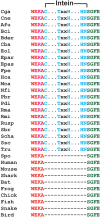Cisplatin protects mice from challenge of Cryptococcus neoformans by targeting the Prp8 intein
- PMID: 31223062
- PMCID: PMC6598491
- DOI: 10.1080/22221751.2019.1625727
Cisplatin protects mice from challenge of Cryptococcus neoformans by targeting the Prp8 intein
Abstract
The Prp8 intein is one of the most widespread eukaryotic inteins, present in important pathogenic fungi, including Cryptococcus and Aspergillus species. Because the processed Prp8 carries out essential and non-redundant cellular functions, a Prp8 intein inhibitor is a mechanistically novel antifungal agent. In this report, we demonstrated that cisplatin, an FDA-approved cancer drug, significantly arrested growth of Prp8 intein-containing fungi C. neoformans and C. gattii, but only poorly inhibited growth of intein-free Candida species. These results suggest that cisplatin arrests fungal growth through specific inhibition of the Prp8 intein. Cisplatin was also found to significantly inhibit growth of C. neoformans in a mouse model. Our results further showed that cisplatin inhibited Prp8 intein splicing in vitro in a dose-dependent manner by direct binding to the Prp8 intein. Crystal structures of the apo- and cisplatin-bound Prp8 inteins revealed that two degenerate cisplatin molecules bind at the intein active site. Mutation of the splicing-site residues led to loss of cisplatin binding, as well as impairment of intein splicing. Finally, we found that overexpression of the Prp8 intein in cryptococcal species conferred cisplatin resistance. Overall, these results indicate that the Prp8 intein is a novel antifungal target worth further investigation.
Keywords: Cisplatin; Prp8 intein; antifungal; mouse model.
Conflict of interest statement
No potential conflict of interest was reported by the authors.
Figures






Similar articles
-
Inteins as Drug Targets and Therapeutic Tools.Front Mol Biosci. 2022 Feb 8;9:821146. doi: 10.3389/fmolb.2022.821146. eCollection 2022. Front Mol Biosci. 2022. PMID: 35211511 Free PMC article. Review.
-
Small-molecule inhibitors for the Prp8 intein as antifungal agents.Proc Natl Acad Sci U S A. 2021 Jan 12;118(2):e2008815118. doi: 10.1073/pnas.2008815118. Proc Natl Acad Sci U S A. 2021. PMID: 33397721 Free PMC article.
-
Spliceosomal Prp8 intein at the crossroads of protein and RNA splicing.PLoS Biol. 2019 Oct 10;17(10):e3000104. doi: 10.1371/journal.pbio.3000104. eCollection 2019 Oct. PLoS Biol. 2019. PMID: 31600193 Free PMC article.
-
Calcimycin Inhibits Cryptococcus neoformans In Vitro and In Vivo by Targeting the Prp8 Intein Splicing.ACS Infect Dis. 2022 Sep 9;8(9):1851-1868. doi: 10.1021/acsinfecdis.2c00137. Epub 2022 Aug 10. ACS Infect Dis. 2022. PMID: 35948057 Free PMC article.
-
The distribution and evolutionary history of the PRP8 intein.BMC Evol Biol. 2006 May 31;6:42. doi: 10.1186/1471-2148-6-42. BMC Evol Biol. 2006. PMID: 16737526 Free PMC article.
Cited by
-
Inteins as Drug Targets and Therapeutic Tools.Front Mol Biosci. 2022 Feb 8;9:821146. doi: 10.3389/fmolb.2022.821146. eCollection 2022. Front Mol Biosci. 2022. PMID: 35211511 Free PMC article. Review.
-
Nanomolar, Noncovalent Antagonism of Hedgehog Cholesterolysis: Exception to the "Irreversibility Rule" for Protein Autoprocessing Inhibition.Biochemistry. 2022 Jun 7;61(11):1022-1028. doi: 10.1021/acs.biochem.1c00697. Epub 2021 Dec 23. Biochemistry. 2022. PMID: 34941260 Free PMC article.
-
Antifungal Drug Repurposing.Antibiotics (Basel). 2020 Nov 15;9(11):812. doi: 10.3390/antibiotics9110812. Antibiotics (Basel). 2020. PMID: 33203147 Free PMC article.
-
Reactive Chlorine Species Reversibly Inhibit DnaB Protein Splicing in Mycobacteria.Microbiol Spectr. 2021 Oct 31;9(2):e0030121. doi: 10.1128/Spectrum.00301-21. Epub 2021 Sep 22. Microbiol Spectr. 2021. PMID: 34549994 Free PMC article.
-
Discovery of highly reactive self-splicing group II introns within the mitochondrial genomes of human pathogenic fungi.Nucleic Acids Res. 2021 Dec 2;49(21):12422-12432. doi: 10.1093/nar/gkab1077. Nucleic Acids Res. 2021. PMID: 34850132 Free PMC article.
References
MeSH terms
Substances
Grants and funding
LinkOut - more resources
Full Text Sources
Other Literature Sources
